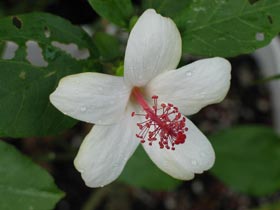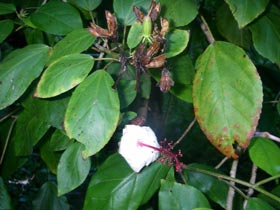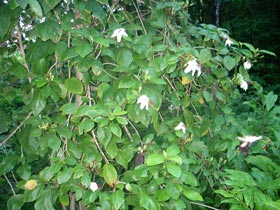Hibiscus waimeae subsp. hannerae
Genus
Hibiscus
Species
waimeae
Subspecies
- hannerae
Hawaiian Names with Diacritics
- Aloalo
- Kokiʻo kea
- Kokiʻo keʻokeʻo
Hawaiian Names
- Aloalo
- Kokio kea
- Kokio keokeo
Common Names
- Kauaʻi white hibiscus
- Minature Hawaiian white hibiscus
- Small Kauaʻi white hibiscus
- White Kauaʻi rosemallow
Distribution Status
Endemic
Endangered Species Status
Federally Listed
Plant Form / Growth Habit
- Shrub
- Tree
Mature Size, Height (in feet)
- Shrub, Medium, 6 to 10
- Shrub, Tall, Greater than 10
Mature Size, Width
From 12 to 14 ft. [Michael DeMotta, National Tropical Botanical Garden]
Life Span
Long lived (Greater than 5 years)
Landscape Uses
- Container
- Screening
- Specimen Plant
Additional Landscape Use Information
This smaller, fragrant flowered species seems more tolerant shade than other native hibiscuses, but will grow well in full sun as well.
Source of Fragrance
- Flowers
Additional Fragrance Information
Flowers can be very fragrant.
Plant Produces Flowers
Yes
Flower Type
Showy
Flower Colors
- Red
- White
Additional Flower Color Information
This kokiʻo keʻokeʻo has small white flowers with red centers or stamens.
Blooming Period
- Year Round
- Sporadic
Additional Blooming Period and Fruiting Information
The flowers are smaller than subsp. waimeae. The plants may cease to bloom for a short period especially during the winter or early spring months. [David Eickhoff, Native Plants Hawaiʻi]
Plant texture
- Medium
- Coarse
Additional Plant Texture Information
Leaves with a slightly rough or a fine sandpaper-like texture, range from 2 to 7 and 10 inches long.
Leaf Colors
- Medium Green
Additional Leaf Color Information
The plant has bigger leaves than ssp. waimeae.
Additional Pest & Disease Information
Kokiʻo keʻokeʻo is prone to sucking insects. The Chinese rose beetle can be removed by hand.
Fertilizer
Fertilize hibiscus using a 2-1-3 or 2-.5-3 ratio with minor elements. It is important to keep the phosphorus low because it tends to accumulate and prevents the nitrogen and potassium from working. Minor elements such as magnesium and iron are also important to maintain healthy green foliage. [1]
Pruning Information
This beautiful shrub looks great in its natural free form. It is best to prune subspecies hannerae only as needed to maintain shape. [Rick Barboza, Hui Kū Maoli Ola]
Water Requirements
- Dry
Additional Water Information
Plants are known to tolerate both dry and moist conditions.
Soil must be well drained
Yes
Light Conditions
- Full sun
- Partial sun
Additional Lighting Information
Plants can tolerate full sun, but seems to prefer some partial shade. [Rick Barboza, Hui Kū Maoli Ola]
Tolerances
- Drought
Soils
- Cinder
- Organic
Natural Zones (Elevation in feet, Rainfall in inches)
- 150 to 1000, 50 to 100 (Mesic)
- 1000 to 1999, 50 to 100 (Mesic)
Additional Habitat Information
A rare hibiscus and found Hanakāpīʻai, Limahuli, and Kalihi Wai valleys in northwestern part of Kauaʻi.
![]() Special Features and Information
Special Features and Information
General Information
The large Mallow family Malvaceae contains some 2,300 species, with notables such as okra, cacao, durian, baobab, kenaf, and cotton. [2]
There are perhaps as many as 300 species worldwide in the genus Hibiscus. There are six native species of hibiscuses in Hawaiʻi and all but one are endemic.
Kokiʻo keʻokeʻo (Hibiscus waimeae) has two subspecies. The subspecies hannerae is federally listed as an endangered species. It is distinguished by the much larger leaves and smaller flowers than appear in subspecies waimeae.
Etymology
The generic name Hibiscus is derived from hibiscos, the Greek name for mallow.
The specific epithet waimeae refers to the Waimea Canyon, Kauaʻi, where this species is found.
The subspecies hannerae was named by the botanist couple Otto and Isa Degener in honor of Mrs. Ruth Knudsen Hanner, a supporter of their work on Kauaʻi. [3]
Hawaiian Names:
Aloalo is the name given for hibiscus in general.
Hau is an introduced hibiscus (Hibiscus tiliaceus), perhaps by early Hawaiians. Hau hele literally means "traveling hau."
Kokiʻo kea and Kokiʻo keʻokeʻo literally mean "white kokiʻo" and "white, white [clear white] kokiʻo," respectively.
Background Information
The two native Hawaiian white hibiscuses, Hibiscus arnottianus and H. waimeae, are the only species of hibiscuses in the world known to have fragrant flowers! Also , See the subheading "Additional Fragrance Information" under "Plant Characteristics" for more information.
New DNA evidence suggests that Hibiscus waimeae subsp. hannerae may now be given full species status as Hibiscus hannerae. [5]
Early Hawaiian Use
Both the native red and white hibiscuses were grown near their houses for their flowers. [4]
Additional References
[1] Jill Coryell, Hibiscus Lady http://www.hibiscusladyhawaii.com/
[2] http://en.wikipedia.org/wiki/Malvaceae [Accessed 10/14/09]
[3] Federal Register. Vol. 61, No. 198, page 48.
[4] "Native Planters in Old Hawaii--Their Life, Lore, & Environment" by E. S. Handy and Elizabeth Green Handy, page 233.
[5] "Hawaii Landscape" Sept./Oct. 2013 issue, pages 16-17.
PHOTOS FOR THIS SPECIES CAN BE SEEN AT THE LINK (Copy & Paste to your browser):
https://www.flickr.com/search/?user_id=50823119%40N08&sort=date-taken-desc&view_all=1&text=Hibiscus%20waimeae%20subsp.%20hannerae
Plant Gallery
Back to Plant List
Other Nursery Profiles for Hibiscus waimeae subsp. hannerae



